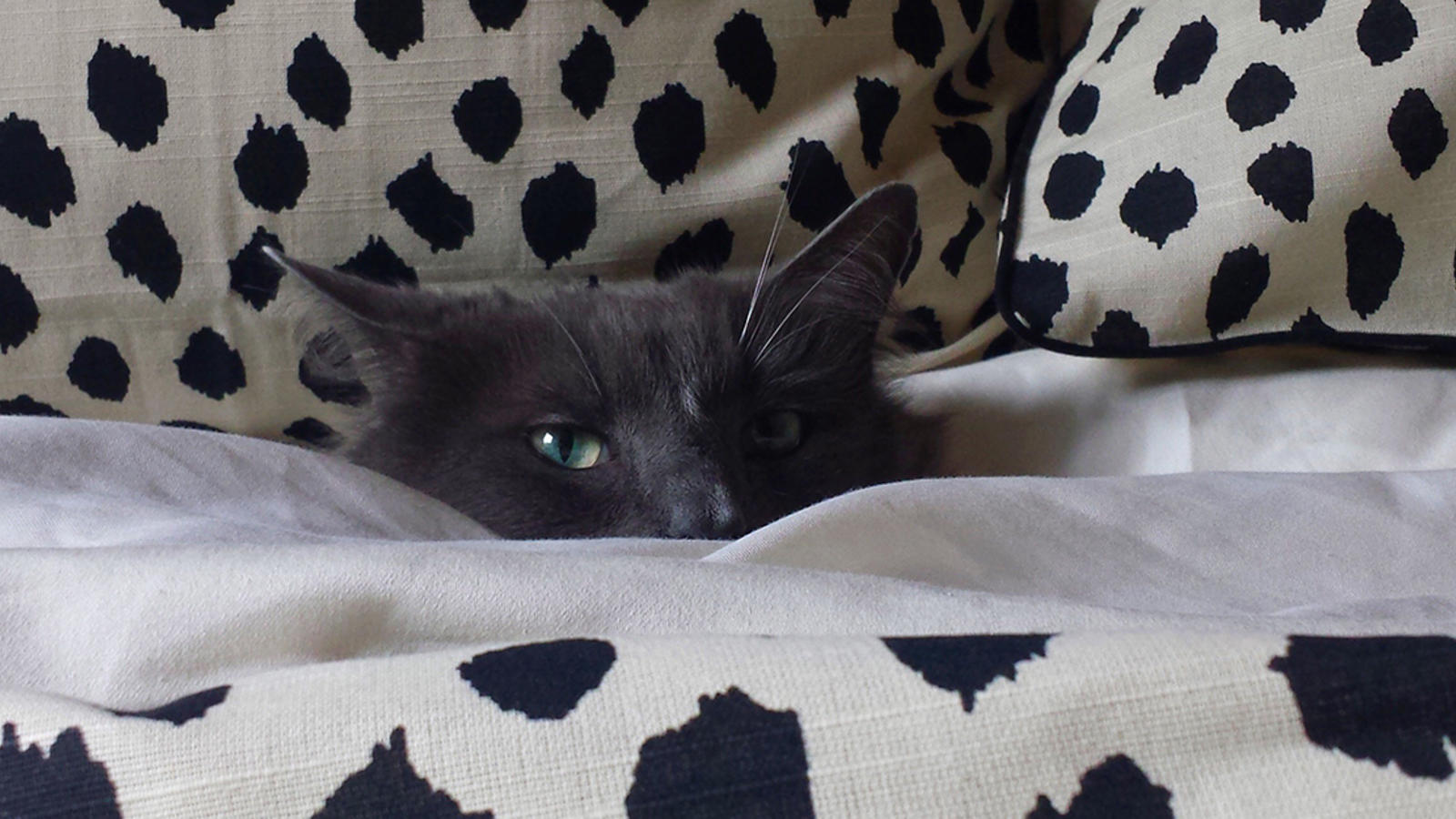
House Of Cats
Why Does A Horde Of Housecats Have Their Own Tiny House?
By Claudia Kolker
Why Does A Horde Of Housecats Have Their Own Tiny House?
Tucked amid the townhouses of Upper Kirby, the small brick building draws little attention. Its lawn is neat, its stairs are swept, its tenants rarely leave. Occasionally, hissing erupts inside. But that's to be expected. All the residents are cats.
The home with the four-legged occupants and chic zip code belongs to Save A Purrfect Cat Rescue, a pet adoption nonprofit. Perhaps unique in the country, SAPCR’s spaces are based on the notion that cats are happiest in human environments. Nearly every detail, from the daybeds to the paintings on the walls, might fit inside a tasteful human home.
It’s an unusual bit of real estate by any measure. The owner, former Houstonian Patti Thomas, lives in Ghana. A clutch of volunteers manage the charity in Houston, operating a showroom where they present foster cats to would-be adopters. At other times, a select few volunteers tend the nearby house of cats: a furnished home occupied solely by animals. Snubbed by adopters for their quirks or ailments, these dozen or so cats will likely never find homes.
Which is why Patti Thomas gave them hers.
***
What kind of human, with real estate worth more than $600,000, gives it up to cats? If you’re not a cat lover, it's tempting to come up with a profile: Someone unsuccessful at regular friendship or love; someone blind to all the humans who are hungry and homeless. That profile would be wrong.
Raised in Illinois farm country, Patti Thomas, now in her 70s, is tall and talkative, with the air of a pioneer woman able to vanquish any obstacle on the trail. In a sense, she has.
As a student at the University of Chicago in the 1960s, she met Len, her future husband, and followed him to the Peace Corps in Ghana. After heading to New York and New Orleans to complete their studies, they returned to Ghana, where Len worked in a hospital and Patti did doctoral research in parasitology. There, they adopted their first pet, a fierce street kitten who caught flies between its paws. Finally returning to New Orleans, the couple happily raised two children and continued their nonprofit work.
Then in 2005, just before Hurricane Katrina descended, Len was diagnosed with a terminal brain tumor. Fleeing to Houston, the family found shelter with Cambodian refugees whom they had sponsored years before. When Len died, Patti’s daughter, then earning a statistics Ph.D. at Rice, persuaded her bereft mother to buy a small vintage building near the university. Patti soon was smitten with the new home. “I will never give this place to developers,” she said.
***
Soon Patti discovered another neighborhood attraction: a wildly energetic woman named Brenda Fraley. A ringer for actress Julianne Moore, Brenda was a former Los Angeles marketing executive who rescued greyhounds. In the late 1990s, after being diagnosed with breast cancer, Brenda moved with her husband to Houston for successful treatment. After noticing the feral cats who seemed to overrun her neighborhood, Brenda began trapping, neutering and hauling them to adoption shows. Her new friend Patti tagged along.
But cats, to be relaxed and most adoptable, need comfort, not the confines of a pet store. A humane adoption center, Brenda thought, should look like a house. In 2010, she rented her own space to show cats. With paint, soft sofas and endless mopping, it looked — and smelled — like a human home.
Patti, meanwhile, had returned to Ghana and community work. But she still owned her old home, plus a nearby rental property. Finances secure, she offered Brenda her now-empty former home as a way station for hard-to-place cats. When it was clear no adopters were pending for many of them, Patti made a decision. She gave her home to the cats.
To ward off animal dumpers, the friends kept the address confidential. Then, in 2015, Patti went further: She gave SAPCR her rental property as a permanent showroom, with Brenda as manager.
“Best thing I’ve ever done,” Patti says. “Somebody might say if I'm going to donate a house, why not to Habitat for Humanity or something? But destitute or homeless humans have more agency to solve their own problems than cats do.”
Inside Patti’s old home, clean floorboards gleam in the sun. A TV screens “Hogan's Heroes.” And dozens of bookshelves bear snoozing cats.
“Cats are 3D,” one volunteer explains. “Dogs and cats both like to move horizontally, but cats also elevate.”
He points to a giant artificial tree trunk, where an orange tabby sleeps on one bough. “This is Newman,” the volunteer says. “And this,” he adds, motioning toward a sleek Bengal cat whose paw touches Newman’s back, “is Princess. She’s in love."
***
In a perfect world, neutering, vaccinating and returning feral cats to the streets would empty most shelters. But in Texas, more unwanted animals are killed than in any other state.
In light of this trend, the gentle spaces that Patti and Brenda offer abandoned cats are groundbreaking, says Holly Sizemore, the program director for Best Friends Utah, the nation’s biggest no-kill shelter. While other shelters offer communal cat rooms and café/shelter partnerships, Sizemore says, SAPCR’s spaces may be the only ones where cats and humans both feel at home.
Like the house of cats, the adoption center looks nothing like a shelter. Instead of institutional paint and easy-wash floors, it’s color-coordinated in a ’50s-style teal and brown, with matching carpet. A leather couch faces a fireplace; a basket of cat magazines stands nearby. In the kitchen, a turquoise coffee machine shares counter space with an immense, crouching tuxedo cat named Millie. Out in the living room, preposterous portraits depict cats in Elizabethan garb. The air is fresh and redolent of lavender.
Patti’s investment in these spaces strikes a chord for Rice Business professor Duane Windsor, who studies heroism. “This is a person the literature would identify as a ‘moral leader,’” he says. “By providing a home for less-adoptable cats, she’s championing animals. By creating an innovative marketplace to connect adopters with cats, she’s helping people and animals. Because humans are better off with a pet.”
***
It's late afternoon in Patti’s old house. Pumpkin, a gorgeous marmalade tabby, lolls by the window. She likes to roll in apparent ecstasy when a certain volunteer approaches, and then when he tries to pet her, bite him. The cat can’t help it.
Under a cocoa-colored blanket on the sofa, a bump slides slowly, finally emerging as a tuxedo cat who darts toward the couch legs. It’s Bailey, nearly always hiding.
Near the roof of the cat tree, Princess, who shrinks from people, taps Newman on the shoulder. He ignores her; he prefers humans. But due to his occasional habit of peeing on pantlegs, Newman, too, may find his love unrequited.
None of these cats, it is plain, qualifies as a perfect human companion. Then again, not many humans qualify either. In Patti’s house, however, perfection is not required. The residents are welcome to savor the sunlight, smooth floors and “Hogan's Heroes,” just as they are. With help from a human well acquainted with loss, displacement and love, here it’s enough to just be a cat.
Claudia Kolker is the associate director of intellectual capital at Rice Business School and author of “The Immigrant Advantage: What We Can Learn From Newcomers To America About Health, Happiness, and Hope."
Never Miss A Story


